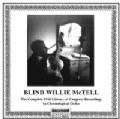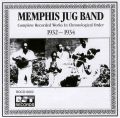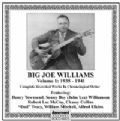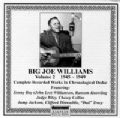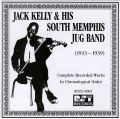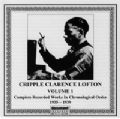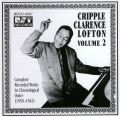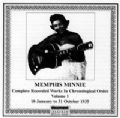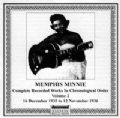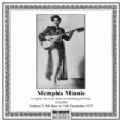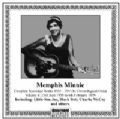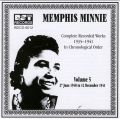"Document 6000 Series "
Viewing 1 to 12 of 50
|
Blind Willie McTell 1940 - Library of Congress Recordings Blind Willie McTell, vocal, twelve-string guitar. Genres; Country Blues / Spirituals / Ragtime Guitar / Bottleneck - slide guitar / Georgia Blues. Descriptive booklet notes by Alan Balfour. Detailed discography. This album presents what must be one of the most historic recordings in African-American history. The result of this encounter in Atlanta, Georgia, was a recorded interview which shone a spotlight onto the life and music of one of the greatest Country Blues names to have been commercially recorded. Presented here in their entirety is a fascinating insight into the man who inspired among others the Allman Brothers, Taj Mahal, Bob Dylan and many others. The history of these Library of Congress, Archive of American Folk Song, recordings is rooted in a visit made by John and Ruby Lomax to Atlanta, Georgia during November 1940. It is reported that Ruby spotted a "Negro man with a guitar" entertaining at a pig n whistle stand. Stopping their car to enquire, they discovered that the individual was Blind Willie McTell. The next morning in their hotel room he "sang and played his 12-string guitar vigorously for two hours", forty or so minutes of which were committed to tape. Continued... More Info on our New Store >> |
||
|
Memphis Jug Band 1932-1934 Picaninny Jug Band: Will Shade, harmonica; Jab Jones, jug; Charlie Burse, vocal, tenor guitar, Vol Stevens, vocal, mandolin, Otto Gilmore, drums
Memphis Jug Band: Same as Picininny Jug Band with appearances by: Charlie Pierce, violin and Robert Burse, drums.
Genres: Blues, Memphis Blues, Country Blues, Jug Bands.
Informative booklet notes by Chris Smith.
Detailed discography.
In 1932 a bunch of musicians traveled to Richmond, Indiana, to cut records for Gennett's soon to be extinct cheap label Champion. Despite, or more likely because of, times being hard, the Picaninny Jug Band's music is generally up tempo, jolly music, with Otto Gilmore's capering percussion strongly featured. Even so, the discs sold poorly.
Some of the titles were to be re-cut at the Memphis jug Band's last, two-day session, for Okeh in 1934. The band that recorded then was an accomplished and versatile unit: Will Shade, Charlie Burse and Jab Jones all sang; Shade played guitar and harmonica, and Burse guitar and mandolin, while Jones doubled piano and jug (unless, as he claimed, Dewey Corley was the jug player for this date). Charlie's brother Robert handled the percussion, while on fiddle there was Charlie Pierce, older than the rest of the band, and formerly a member of W C. Handy's Orchestra. Continued... More Info on our New Store >> |
||
|
Big Joe Williams Vol 1 1935 - 1941 Big Joe Williams; vocal, Nine-string guitar, bottleneck guitar. With contributions by Sonny Boy (John Lee) Williamson, harmonica; Henry Townsend, guitar; Robert “Nighthawk” Lee McCoy, guitar and others... Genre: Mississippi Country Blues Big Joe Williams, was born in Mississippi, most likely in October, 1903 At one time it was customary to regard Big Joe Williams as a good journeyman blues singer but not of the first rank, like a Patton, Jefferson or McTell. That he was a survivor who, by the late sixties, had already made a lot of records probably worked against his reputation. However, by any assessment, his first session and indeed all of his Bluebird recordings, require a radical reappraisal of his position in the Blues Pantheon. This most impressive debut session has the impact of a Bukka White on Vocalion/Okeh or John Estes on Champion/Decca. For four decades Joe featured his unique, patched-up nine string guitar but on his first recordings he was still playing a conventional six-string guitar in a complex style that meshed excitingly with fellow St. Louis guitarist Henry Townsend's playing. Continued... More Info on our New Store >> |
||
|
Big Joe Williams Vol 2 1945 - 1949 Big Joe Williams; vocal, Nine-string guitar, bottleneck guitar. Includes; Sonny Boy (John Lee) Williamson, harmonica; Chasey Jones, vocal, washboard; Ransom Knowling, bass; Judge Riley, drums and others... Genre: Mississippi Country Blues Big Joe Williams was born in, most likely in October, 1903. Joe’s first recordings were made for Bluebird in February 1935 and in October of that year he recorded with two other musicians, Chasey Collins from Alabama probably played the washboard, while an old timer from Memphis, “Dad” Tracey, played the one string-fiddle. In addition to four Joe Williams vocals, Chasey Jones sang two excellent blues; Walking Blues is unrelated to the Son House / Robert Johnson blues but has verses used earlier by Kokomo Arnold and later by Tommy McClennan (“You Can Mistreat Me Here”). Joe later adopted the piece as “Walk On Little Girl”, Atlanta Town is a vocal tour-de-force, with wild accompaniment, which makes one wish that Collins had recorded more. Continued... More Info on our New Store >> |
||
|
Jack Kelly & His South Memphis Jug Band 1939 - 1939 Jack Kelly, vocal, guitar. Genres: Memphis country blues. Jug band. Memphis boasted a preponderance of jug bands and when record companies finally got round to recording the genre there were at least six formally organised bands working in the city. Four of those, Will Shade’s Memphis Jug Band, Gus Cannon’s jug Stompers, Jed Davenport’s Beale Street Jug Band and Jack Kelly’s South Memphis Jug Band, had fairly flourished recording careers. Little is known of Jack Kelly. It is thought that he was born in northern Mississippi at the turn of the century, moving to Memphis in the twenties where he remained until his death around 1960. He is remembered as a street musician who worked with guitarist Frank Stokes, Dan Sane and fiddle player, Will Batts. Later Kelly, Sane and Batts augmented their sound with a jug player, DM Higgs, forming a group called the South Memphis Jug Band. Their repertoire tended to favour blues based material and the combination of two guitars, violin and jug produced a decidedly “country blues”. Continued... More Info on our New Store >> |
||
|
Cripple Clarence Lofton Vol 1 1935 - 1939 Cripple Clarence Lofton; piano, vocal. Genres: Blues Piano Inforamative Booklet Notes by Keith Briggs. Research has pin-pointed Clarence's birth to March 28th 1887 in Kingsport, Tennessee. He moved to Chicago around 1917 at the age of forty. Surprisingly, it was not until he was in his late forties when he first recorded, for Vocalion, in April 1935. In the company of Big Bill Broonzy he cut two tracks utilising themes that would recur time and again throughout his eight year career on record. On this occasion both piano performances were subservient to his hoarse vocals which were taken at a break-neck pace on Strut That Thing, the number being driven along by an unknown washboard player, and more reflectively on Monkey Man Blues which was enhanced by Big Bill's distinctive guitar work. Continued... More Info on our New Store >> |
||
|
Cripple Clarence Lofton Vol 2 1939 - 1943 Cripple Clarence Lofton; vocal, piano. Genres: Blues Piano, Boogie-woogie piano. Tennessee / Chicago Inforamative Booklet Notes by Keith Briggs. Clarence Lofton was a well known figure on the bar and party circuit in Chicago by the time white jazz fan Dan Qualey, through the good offices of Jimmy Yancey, located him playing in a sleazy State Street bar called The Big Apple and convinced him to record for the Solo Art label around 1939. The records were well received, although his treatment of the sacrosanct Pine Top’s Boogie Woogie raised a few eyebrows and Clarence slipped easily into the role of natural, untutored (and therefore “pure”) “proto-boogiest” for the keen new audience of white fans who were attracted by his rugged style and insouciant disregard for formal structure. As well as the four issued tracks nine others were recorded and it is those that open this volume. “The Fives” appears as Sixes And Sevens (Clarence had both a sense of humour and ego) while Lofty Blues reworks the amazing, issued “Had A Dream” at a faster tempo and with a different bass line. Continued... More Info on our New Store >> |
||
|
Memphis Minnie Vol 1 1935 Memphis Minnie; vocal, guitar. With contributions by; Black Bob, piano; Casey Bill Weldon, slide steel guitar, and others... Genres: Country blues / early Chicago blues. With her musical and personal relationship with Kansas Joe McCoy ended, new directions inevitably had to be sought for Memphis Minnie’s recording career. An air of experimentation can be detected in her first visits to the recording studio in 1935. The January 10th session is distinguished by a fine pianist whom she addresses as “Jimmie”, which is generally taken to indicate Jimmie Gordon. Two of the numbers recorded are stomping bawdy songs, Sylvester And His Mule is textually more interesting. Telling of a cotton-pickers’ (successful) appeal to President Roosevelt, it reflects optimism in the black community about the New Deal. Continued... More Info on our New Store >> |
||
|
Memphis Minnie Vol 2 1935 - 1936 Memphis Minnie; vocal, guitar. December 1935 found Memphis Minnie back in the Chicago studios of what was then the American Recording Company and she would record for no one else for fourteen years. After the experimentation of 1935, the emphasis in her recording career now shifted decisively to the band sound characteristic of Chicago in the later thirties. The changes reflect a demand for overtly danceable rhythms and can be seen as an early portent of the process by which blues merged with small-band swing to become rhythm and blues. Continued... More Info on our New Store >> |
||
|
Memphis Minnie Vol 3 1937 Memphis Minnie; vocal, guitar. Genres: Chicago Blues Informative booklet notes by Howard Rye. Memphis Minnie’s ‘band period’, discussed in the notes to BDCD-6009, continued through 1937 though with some changes in emphasis. Seven months elapsed after the session of November 1936 before she returned to the Vocalion studios. A trumpeter was again on hand playing in a fiery style. Certainly, some listeners will feel that this rough, blues style is appropriate to the task of accompanying Memphis Minnie. The pianist on the June 1937 sessions plays a much less prominent role than Black Bob had played during 1936. Whoever was involved, the result is that Minnie herself dominates these sessions, aggressive both instrumentally and vocally. “You can’t take my money, man, and rule me too!”, she cries, “I done got tired of your 3-6-9” an allusion to the number combination for excrement (i.e. shit) in the lore of the policy game. Continued... More Info on our New Store >> |
||
|
Memphis Minnie Vol 4 1938 - 1939 Memphis Minnie; vocal, guitar. With contributions by;Little Son Joe, vocal guitar.Charlie McCoy, mandolin. Black Bob, piano and others... Informative booklet notes by Howard Rye. Memphis Minnie had only one recording date in 1938. Its unusual atmosphere is attributable in main to Charlie McCoy’s mandolin, which introduces a whiff of string bands and minstrelsy, especially noticeable on Long As I Can See You Smile. Genuine double meanings are rare, but the advice in Good Biscuits, “Don’t let no outside woman bake no biscuits for you man,” is equally valid whether taken literally of metaphorically, not that I imagine that the literal meaning was uppermost in the minds of either performers or listeners. The theme is continued in Keep On Eating. Minnie obviously belied in the old saying that the way to a man’s heart is through his stomach. Continued... More Info on our New Store >> |
||
|
Memphis Minnie Vol 5 1940 - 1941 Memphis Minnie; vocal, guitar. Includes; Little Son Joe, vocal, guitar and others... Genres: Memphis / Chicago Blues Informative booklet notes by Howard Rye. After the long interval since their previous session Minnie and Joe’s June 1940 session is marked by a sense of commanding confidence, and notably inspired instrumental choruses. “You may go to Hollywood and try to get on screen, The reminiscent mood extends to the remarkable Ma Rainey, a tribute to an acknowledged influence who had died in December 1939. It is replete with the paradox of wondering in the first verse, “where could Ma Rainey be”, and making clear in the last that she is known to be dead: “People, it sure look lonesome, since Ma Rainey been gone, Continued... More Info on our New Store >> |
||

